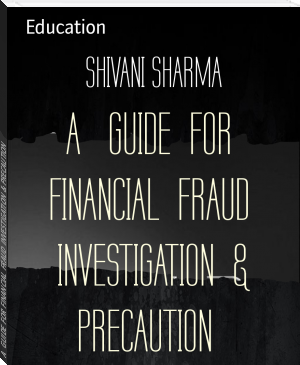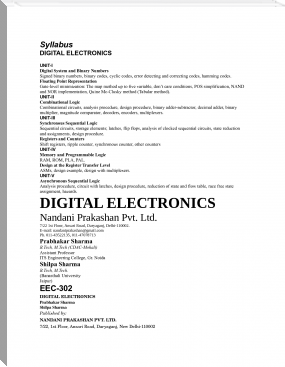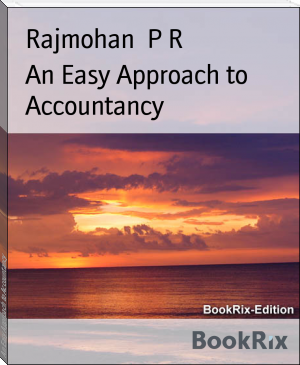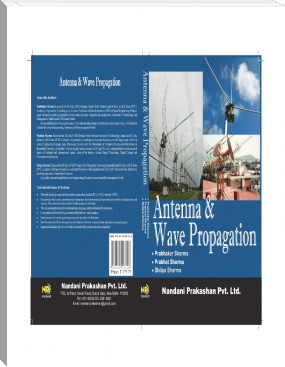A GUIDE FOR FINANCIAL FRAUD INVESTIGATION & PRECAUTION by SHIVANI SHARMA (books to read for beginners .txt) 📕

- Author: SHIVANI SHARMA
Book online «A GUIDE FOR FINANCIAL FRAUD INVESTIGATION & PRECAUTION by SHIVANI SHARMA (books to read for beginners .txt) 📕». Author SHIVANI SHARMA
In many ways, the new frontier of money laundering and criminal activity lays in cryptocurrencies. While not totally anonymous, these forms of currencies are increasingly being used in currency blackmailing schemes, drug trade and other criminal activities due to their anonymity compared to other forms of currency.
Money can also be laundered through online auctions and sales, gambling websites and even virtual gaming sites, where ill-gotten money is converted into gaming currency, then transferred back into real, usable and untraceable "clean" money.
Anti-money-laundering laws (AML) have been slow to catch up to these types of cybercrimes, since most AML laws attempt to uncover dirty money as it passes through traditional banking institutions. As money launderers attempt to remain undetected by changing their approach, keeping one step ahead of law enforcement, international organizations and governments are working together to find new ways to detect them.
5).COMBATING MONEY LAUNDERING:- The government has become increasing vigilant in its efforts to combat money laundering over the years by passing anti-money-laundering regulations. These regulations require financial institutions to have systems in place to detect and report suspected money-laundering activities.
In 1989, the Group of Seven (G-7) formed an international committee called the Financial Action Task Force (FATF) in an attempt to fight money laundering on an international scale. In the early 2000s, its purview was expanded to combating the financing of terrorism.
The United States passed the Banking Security Act in 1970, requiring financial institutions to report certain transactions to the Department of the Treasury, such as cash transactions above $10,000 or any transactions they deem suspicious, on a suspicious activity report (SAR).
The information these banks provide to the Treasury Department is used by the Financial Crimes Enforcement Network (FinCEN), where it can then be sent to domestic criminal investigators, international bodies or foreign financial intelligence units.
While these laws were helpful in tracking criminal activity through financial transactions, money laundering itself wasn't made illegal in the United States until 1986, with the passage of the Money Laundering Control Act. This law removed limits on the amount of money involved and individual intent to give the federal government more room to prosecute money laundering.Shortly after the 9/11 terrorist attacks, The USA Patriot Act strengthened money-laundering prevention by allowing the use of investigative tools designed for organized crime and drug trafficking prevention for terrorist investigations. Title III of the Patriot Act, called the "International Money Laundering Abatement and Financial Anti-Terrorism Act of 2001," seeks to prevent the exploitation of the American financial system by parties suspected of terrorism, terrorist financing and money laundering. The law imposes strict bookkeeping requirements and also authorizes the Secretary of the U.S. Treasury to develop regulations that encourage better communication between financial institutions with the goal of making it more difficult for money launderers to hide their identities. The Treasury can also halt the merger of two banking institutions if both entities have a history of failing to put adequate anti-money-laundering procedures in place.
The Association of Certified Anti-Money Laundering Specialists (ACAMS) offers a professional designation known as a Certified Anti-Money Laundering Specialist (CAMS). Requirements to gain CAMS certification include obtaining 40 qualifying credits based on education, work experience and other professional certifications, and passing the CAMS examination. Professionals who earn CAMS certification may work as brokerage compliance managers, Bank Secrecy Act officers, financial intelligence unit managers, surveillance analysts and financial crimes investigative analysts.
6)IMPACT OF MONEY LAUNDERING:- According to a 2016 survey from PwC, global money laundering transactions account for roughly 2% to 5% of global GDP, or roughly $1 trillion to $2 trillion annually.Although the act of money laundering itself is a victimless, white-collar crime, it is often connected to serious and sometimes violent criminal activity. Being able to stop money laundering is, in effect, being able to stop the cash flows of criminals, including international organized crime.
Money laundering also impacts legitimate business interests by making it much more difficult for honest businesses to compete in the market since money launderers often provide products or services at less than market value. Where a financial institution or business is also regulated by the government, money laundering, or a failure to put reasonable anti-laundering policies in place, can result in a revocation of a business charter or government licenses. Businesses that associate with people, countries or entities that launder money face the possibility of fines. Deutsche Bank, ING, the Royal Bank of Scotland, Barclays and Lloyds Banking Group are among institutions that have been fined for being involved with transactions associated with money-laundering activities in countries such as Iran, Libya, Sudan and Russia.
In one famous money-laundering case, international bank HSBC was fined for a failure to put proper anti-money laundering measures in place. According to the U.S. federal government, HSBC was guilty of little or no oversight of transactions by its Mexican unit that included providing money-laundering services to various drug cartels involving bulk movements of cash from HSBC's Mexican unit to the Unites States. The government said HSBC failed to maintain proper records as part of its AML measures. This included a huge backlog of unreviewed accounts and a failure by HSBC to file suspicious activity reports. After a year-long investigation, the federal government indicated HSBC had failed to comply with U.S. banking laws and consequently subjected the United States to Mexican drug money, suspicious traveler's checks and bearer share corporations. In 2012, the bank agreed to pay $1.92 billion in fines to U.S. authorities.
Economy is also affected through money laundering on economic development can be qualified in term of three sector of the ECONOMY: financial, real and external.Money laundering damages the financial sector institution that are critical to economy growth, reduce productivity in the economy in real sector by diverting resources and encouraging crime and corruption which slow down the economy growth , distort the economy external sector international trade and capital flow to the determinnt of long-term economy development.
7).ACT OR PMLA-2002;- Come into enforcement with effect from 1 july 2005. Act extent to whole india expect jammu and kashmir. The objective of PLMA is to prevent money laundering , seize the property with authority which involve in money laundering.
8).ADMINISTRATION:- Disectorate of enforcement of department of revenue,Ministry of finance.Director were appointed by central goverment.
9)What is the offence of Money Laundering?
Whosoever directly or indirectly attempts to indulge or knowingly assists or knowingly is a party or is actually involved in any process or activity connected with the proceeds of crime including its concealment, possession, acquisition or use and projecting or claiming it as untainted property shall be guilty of offence of money laundering (Section 3).
10)What are proceeds of crime?
“Proceeds of crime” means any property derived or obtained, directly or indirectly, by any person as a result of criminal activity relating to a scheduled offence or the value of any such property [Section 2(1)(u)].
11)What is a ‘scheduled offence’?
The offences listed in the Schedule to the Prevention of Money Laundering Act, 2002 are scheduled offences 10 in terms of Section 2(1)(y) of the Act. The scheduled offences are divided into two parts - Part A & Part C.
In part A, offences to the Schedule have been listed in 28 paragraphs and it comprises of offences under Indian Penal Code, offences under Narcotic Drugs and Psychotropic Substances, offences under Explosive Substances Act, offences under Unlawful Activities (Prevention) Act, offences under Arms Act, offences under Wild Life (Protection) Act, offences under the Immoral Traffic (Prevention) Act, offences under the Prevention of Corruption Act, offences under the Explosives Act, offences under Antiquities & Arts Treasures Act etc.
Part ‘C’ deals with trans-border crimes, and is a vital step in tackling Money Laundering across International Boundaries.
Prior to 15th February, 2013, i.e., the date of notification of the amendments carried out in PMLA, the Schedule also had Part B for scheduled offences where the monetary threshold of rupees thirty lakhs was relevant for initiating investigations for the offence of money laundering. However, all these scheduled offences, hitherto in Part B of the Schedule, have now been included in Part A of Schedule w.e.f 15.02.2013. Consequently, there is no monetary threshold to initiate investigations under PMLA.
12)What is a Predicate Offence?
Every Scheduled Offence is a Predicate Offence. The Scheduled Offence is called Predicate Offence and the occurrence of the same is a pre requisite for initiating investigation into the offence of money laundering.
13)Who can investigate a case of Money Laundering ?
As per Sections 48 & 49 of the PMLA, the officers of the Directorate of Enforcement have been given powers to investigate cases of Money Laundering. The officers have also been authorised to initiate proceedings for attachment of property and to launch prosecution in the designated Special Court for the offence of money laundering.
14)The powers available to the Investigating Officers under the Act:-The Investigating Officers have the powers:-
(a) to provisionally attach any property derived or obtained, directly or indirectly, by any person as 13 a result of criminal activity relating to a scheduled offence or the value of any such property [Section 5];
(b) to conduct survey of a place [Section 16];
(c) to conduct search of building, place, vessel, vehicle or aircraft & seize/freeze records & property [Section 17];
(d) to conduct personal search [Section 18];
(e) to arrest persons accused of committing the





Comments (0)